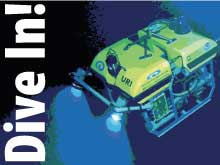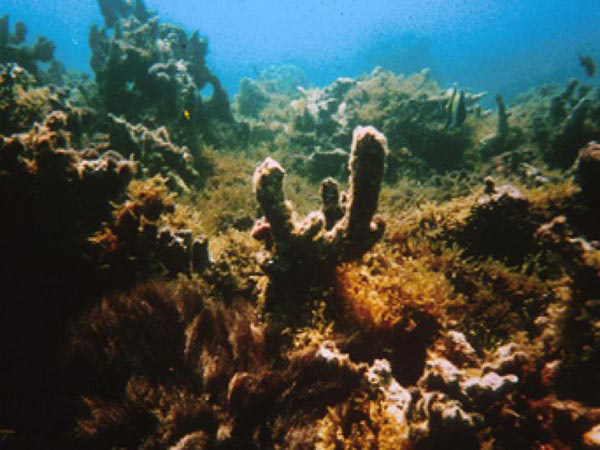
These lesson plans focus on the cutting-edge ocean exploration and research using state-of-the-art technologies and include topics such as light, color, and camouflage in the deep ocean; polarization vision; and vision in crustaceans.
Education Lesson Plans
The National Oceanic and Atmospheric Administration (NOAA) has a great opportunity to reach out in new ways to teachers, students, and the general public through its ocean exploration efforts and share the excitement of daily at-sea discoveries and the science behind its major ocean exploration initiatives with the people around the world. The Florida Coast Deep Corals 2005 Expedition presents a unique opportunity to engage explorers of all ages as we continue our journeys to a deep-sea coral world that few have seen. Our ongoing studies (2000-present) exploring southeastern US (SEUS) and Gulf of Mexico continental slope coral ecosystems are based on hypotheses that these habitats are ecologically important and productive, yet they are poorly documented. There is increasing evidence that deep-sea (aphotic) corals are important fish habitat, hold data on ocean climate and productivity, and are hotspots of biodiversity, including new species. In fact, the SEUS and Gulf of Mexico may have the most extensive deep-sea coral areas in the US. Locating, describing, and mapping deep-sea corals and conducting basic biological studies in these habitats are priorities for our exploration efforts. Our previous expeditions have documented deep-sea coral and outer shelf reef habitats and associated biota, but these missions have only begun to quantify this extensive habitat in the region. Our findings have yielded many new records of biota, new ecological data, new data on habitat distributions/structures, and data on water column trophic connectivity. This expedition continues and expands our explorations of these unique and relatively unknown deep water habitats, using conventional sampling techniques coupled with cutting-edge technologies, such as the Harbor Branch Oceanographic Institution's human-occupied submersible Johnson-Sea-Link.
Educators and scientists working with NOAA developed a series of lesson plans for students in Grades 5 - 12 that are specifically tied to the science behind the Florida Coast Deep Corals 2005 Expedition. These lesson plans focus on cutting-edge ocean exploration and research using state-of-the-art technologies.
The lesson plans are grouped into the following categories:
Grades 5-6
Grades 7-8
Grades 9-12 (Chemical, Biological, Earth, and Physical
Science)
In addition to being tied to the National Science Education Standards, the hands-on, inquiry-based activities include focus questions, background information for teachers, links to interesting Internet sites, and extensions. Web logs that document the latest discoveries and complement the lesson plans, complete with compelling images and video, will be sent back each day from sea. Teachers are encouraged to use the daily logs from the Florida Coast Deep Corals 2005 Expedition, which are posted on this site, to supplement the lesson plans.
Read a description of each lesson plan and/or download them
to your computer. All of the lesson plans are available in PDF format,
and may be viewed and printed with the free Adobe Acrobat Reader ![]() . To download a lesson plan, click on its title from
the listing below.
. To download a lesson plan, click on its title from
the listing below.
Deep Gardens (8 pages, 359k)
Focus: Comparison of deep-sea and shallow-water tropical coral reefs (Life Science)
In this activity, students will compare and contrast deep-sea coral reefs with their shallow-water counterparts, describe three types of coral associated with deep-sea coral reefs, and explain three benefits associated with deep-sea coral reefs. Students will explain why many scientists are concerned about the future of deep-sea coral reefs.
Treasures in Jeopardy, (6 pages, 299k)
Focus: Conservation of deep-sea coral reefs (Life Science)
In this activity, students will compare and contrast deep-sea coral reefs with their shallow-water counterparts and explain at least three benefits associated with deep-sea coral reefs. Students will also describe human activities that threaten deep-sea coral reefs and describe actions that should be taken to protect deep-sea coral reef resources.
Are You Related? (11 pages, 465k)
Focus: Molecular genetics of deepwater corals (Life Science)
In this activity, students will define "microsatellite markers" and explain how they may be used to identify different populations and species, explain two definitions of "species," and describe processes that result in speciation. Students will also use microsatellite data to make inferences about populations of deep sea corals.
For More Information
Contact Paula Keener-Chavis,
Director, Education Programs
NOAA Office of Ocean Exploration
Other lesson plans developed for this Web site are available in the Education Section.
























